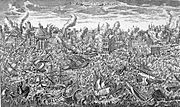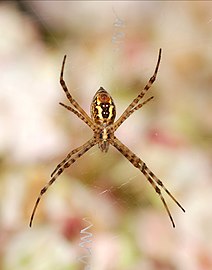Portal:Portugal
  Portugal, officially the Portuguese Republic, is a country located on the Iberian Peninsula in Southwestern Europe, whose territory also includes the Macaronesian archipelagos of the Azores and Madeira. It features the westernmost point in continental Europe; its mainland west and south border with the North Atlantic Ocean; and in the north and east, the Portugal-Spain border, which constitutes the longest uninterrupted border line in the European Union. Portugal is the oldest nation-state in Europe. Founded in 1143, its current borders were established in mid-13th century, making them some of the most ancient in Europe and the world. Its archipelagos form two autonomous regions with their own regional governments. On the mainland, the Alentejo region occupies the biggest area but is one of the least densely populated regions of Europe. Lisbon is the capital and largest city by population, and it is also the main spot for tourists alongside Porto, the Algarve and Madeira. As one of the oldest countries in Europe, its territory has been continuously settled and fought over since prehistoric times. The territory was inhabited by the Celtic and Iberian peoples. It was later ruled by the Romans, followed by the invasions of Germanic peoples together with the Alans and later the Moors, who were eventually expelled during the Reconquista. First founded as a county within the Kingdom of León in 868, Portugal formally became an independent kingdom with the Treaty of Zamora in 1143. During the Age of Discovery, particularly in the 15th and 16th centuries, Portugal established one of the longest-lived maritime and commercial empires, becoming one of the main economic and political powers of the time. By the early 19th century, events such as the 1755 Lisbon earthquake, the country's occupation during the Napoleonic Wars, and the resulting independence of Brazil in 1822 led to a marked decay of Portugal's prior opulence. This was followed by the civil war between liberal constitutionalists and conservative absolutists over royal succession from 1828 to 1834. The 1910 revolution deposed Portugal's monarchy and established the democratic but unstable Portuguese First Republic, later superseded by the authoritarian regimes of Ditadura Nacional (National Dictatorship) and Estado Novo (New State). Democracy was restored after the Carnation Revolution (1974), ending the Portuguese Colonial War and eventually losing its remaining colonial possessions. (Full article...)
Fort of Santa Cruz (Portuguese: Forte de Santa Cruz da Horta or Castelo da Santa Cruz), is a 16th-century fortification located in the civil parish of Angústias, municipality of Horta, on the island of Faial in the Portuguese Azores. Occasionally referred to as the Castelo de Santa Cruz by locals, it is situated in the historic centre of the city, on the edge of Horta Bay. It was constructed to work in conjunction with the Fort of Bom Jesus (Portuguese: Forte do Bom Jesus) at the mouth of the Ribeira da Conceição and Fort of Greta (Portuguese: Forte da Greta) along the coast of the extinct spatter cone Monte da Guia, to defend the entrance to the harbour and southern access to the Bay. (Full article...)
This is a Featured article, which represents some of the best content on English Wikipedia.
The 2005 Azores subtropical storm was the 19th nameable storm and only subtropical storm of the extremely active 2005 Atlantic hurricane season. It was not named by the National Hurricane Center as it was operationally classified as an extratropical low. It developed in the eastern Atlantic Ocean, an unusual region for late-season tropical cyclogenesis. Nonetheless, the system was able to generate a well-defined centre convecting around a warm core on 4 October. The system was short-lived, crossing over the Azores later on 4 October before becoming extratropical again on 5 October. No damages or fatalities were reported during that time. Its remnants were soon absorbed into a cold front. That system went on to become Hurricane Vince, which affected the Iberian Peninsula. The subtropical nature of this unnamed system was determined several months after the fact, while the National Hurricane Center was performing its annual review of the season. Upon reclassification, the storm was entered into HURDAT, the official hurricane database. (Full article...)The following are images from various Portugal-related articles on Wikipedia.
"There are several kinds of states: socialist states, corporative states, and the state we've arrived at!"
Há diversas modalidades de Estado: os estados socialistas, os estados corporativos e o estado a que isto chegou! Salgueiro Maia to his troops on the evening of 24 to 25 April 1974 This is a Good article, an article that meets a core set of high editorial standards.
 Caldas da Rainha (European Portuguese: [ˈkaldɐʒ ðɐ ʁɐˈiɲɐ] ) is a medium-sized Portuguese city in the Oeste region, in the historical province of Estremadura, and in the district of Leiria. The city serves as the seat of the larger municipality of the same name and of the Comunidade Intermunicipal do Oeste (OesteCIM, Intermunicipal Community of the West). At the 2011 census, the municipality had a population of 51,729 in an area of 255.69 square kilometres (98.72 sq mi), with 30,343 residing in the city. Although the city itself lies about 10.5 kilometres (6.5 mi) inland, three of the municipality's civil parishes lie on the Atlantic Ocean. Caldas da Rainha is best known for its sulphurous hot springs and ceramic pottery. The settlement was founded in the 15th century by Queen Leonor (Rainha Dona Leonor), who established a hospital and a church at the site of some therapeutic hot springs. The Hospital Termal Rainha D. Leonor (Queen Leonor Spring Water Hospital, or Thermal Hospital) is the oldest purpose-built institution of its kind in the world, with five centuries of history. The city's name, often shortened to simply "Caldas", can be translated as "Queen's Hot Springs", "Queen's Spa", or "Queen's Baths". (Full article...)D. Vasco da Gama, 1st Count of Vidigueira (/ˌvæsku də ˈɡɑːmə, - ˈɡæmə/ VAS-koo də GA(H)M-ə; European Portuguese: [ˈvaʃku ðɐ ˈɣɐmɐ]; c. 1460s – 24 December 1524), was a Portuguese explorer and nobleman who was the first European to reach India by sea. His initial voyage to India by way of Cape of Good Hope (1497–1499) was the first to link Europe and Asia by an ocean route, connecting the Atlantic and the Indian oceans. This was a milestone in Portuguese maritime exploration as and marked the beginning of a sea-based phase of globalization. Da Gama's discovery of the sea route to India opened the way for an age of global imperialism and enabled the Portuguese to establish a long-lasting colonial empire along the way from Africa to Asia. Traveling the ocean route allowed the Portuguese to avoid sailing across the highly disputed Mediterranean Sea and traversing the dangerous Arabian Peninsula. The sum of the distances covered in the outward and return voyages made this expedition the longest ocean voyage ever made until then. (Full article...) The battle of Aljubarrota took place on August 14, 1385, between Portuguese forces commanded by King John I of Portugal and his general Nuno Álvares Pereira, and the Castilian army of John I of Castile.
Featured articlesFormer featured articlesFeatured listsFormer featured listsGood articles
Former good articlesDid you know? articles
Featured pictures
Former featured portalsIn the News articles
Main page featured articles
Picture of the day pictures
Featured topicsThis list was generated from these rules. Questions and feedback are always welcome! The search is being run daily with the most recent ~14 days of results. Note: Some articles may not be relevant to this project.
Rules | Match log | Results page (for watching) | Last updated: 2024-09-19 22:00 (UTC) Note: The list display can now be customized by each user. See List display personalization for details.
The following Wikimedia Foundation sister projects provide more on this subject:
Discover Wikipedia using portals |













![Image 11Maios celebration in Madeira island [1] (from Culture of Portugal)](http://upload.wikimedia.org/wikipedia/commons/thumb/e/e1/2011-03-05_03-13_Madeira_045_Santana_%285543431418%29.jpg/180px-2011-03-05_03-13_Madeira_045_Santana_%285543431418%29.jpg)
































































































